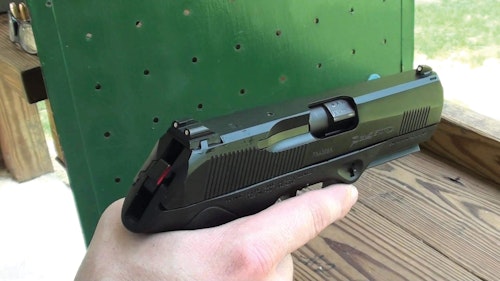If you stood a target in front of a customer and asked them to point their finger at the center, it wouldn’t take much effort. They could do so instantly and, more importantly, without thought. If you asked them to put their hands by their side, close their eyes, and repeat the exercise, you’d find that their finger would still be pointing at the target when they open their eyes. It’s something that we’ve all done countless times and it is automatic or “natural.”
The point (pun intended) in natural point of aim is to be able to do the same thing with a firearm. It’s for the guns to be a natural extension of the hand rather than a tool. This is the holy grail of gun fitment and why there have been so many articles written on how to select the right gun. The problem is that shooting a gun isn’t a natural act. It’s a learned skill. Most skills a new shooter learns are relatively easy. It’s not rocket science. All it takes is proper instruction and lots of practice.
You’ve heard the term “muscle memory.” It refers to the skills developed through repeated practice that eventually become automatic. Thinking isn’t necessary; they just happen. We stress the need for shooters to develop muscle memory with each of their pistol-handling skills, because that’s the level of skill needed in a critical situation. It’s why the first gun “accessories” should be a case of practice ammo and a range pass.
Muscle Memory
Statistics repeatedly show the reason 75 to 80% of people are buying handguns is for self-defense or home protection. They are trying to prepare for situations where the level of stress is as high as can possibly be experienced. When facing a life-or-death situation, the brain experiences the “fight, flight, or freeze” response. The body is programmed to react in one of these three ways. One aspect of Fight, Flight, or Freeze is that critical thinking skills quickly deteriorate (as do many physical skills). Muscle memory allows the body to respond without conscious thought, freeing the brain to use its diminished power of concentration on what is most important — surviving.
Why NPOA is Important
What if the time developing one of those skills could be reduced or eliminated? What if it was one of the most important skills for accurate shooting? That would save the shooter lots of ammo and time. It would also raise the chances of survival in a gunfight.
Having a gun that points as naturally as one can point a finger reduces the need to concentrate on aiming. Aiming is still a needed skill for longer distance shots, but police studies have shown that in self-defense distances (3 - 15 feet) most people resort to point shooting anyway. Thus, NPOA may be one of the most impactful aspects of survival.
Checking Point of Aim
Surprisingly, you already know how to help your customer find their NPOA. It’s almost identical to the finger-pointing exercise above. The difference is that it’s done with a gun rather than a finger. Have a customer establish a proper grip and hold a handgun naturally by their side with the muzzle pointing down. Ask them to raise the pistol to aim at a target. Next, have them keep their grip and wrist angle the same and repeat the process with their eyes closed. The sights will point to their NPOA with that particular handgun. The goal is to find the right gun, or modifications to the chosen gun, to achieve a NPOA that is automatically on target.
It’s important to note that when the customer opens their eyes, their brain will automatically attempt to correct the sight picture by aiming. They must be warned about this, or they will get false results.
Grip Angle
There’s a lot of debate in the gun community about the importance of grip angle on pointability. This is usually between the 1911 aficionados and the Glock fans. The 1911 has a grip angle of 18-degrees, while the Glock’s angle is a steeper 22-degrees. If a shooter holds their wrist at the same angle and alternates between the two guns, the Glock will naturally point higher on the target than the 1911. To the 1911 guys, that’s a design fault. Those who prefer the Glock’s angle argue that it’s not a problem but rather an intentional design decision. (Incidentally, most target pistols are designed with a 35-degree grip angle).
Most guns made for the American market have been made with the 18-degree grip angle, possibly because that was what most revolvers were. Shooters who learned to shoot with one of these guns have developed a “natural feel” for that angle and find the Glocks more difficult to aim. The opposite is true for those who’ve been taught to shoot Glocks. One is not superior to the other. They are merely different. New shooters can be proficient with either. As one blog comment I read stated, “It’s like the difference between putting your car’s steering wheel on the left and driving on the right side of the road or placing it on the right and driving on the left side – just pick one and stick with it.”
As expected, there are guys who say it’s all hogwash. They say they shoot both guns well. What they don’t say is that one is natural and the other must be consciously aimed. For recreational shooting, it’s not an issue. Simply, take the time and aim. But if the goal is competition of self-defense, time is critical. Shaving off fractions of a second may be the difference in survival. Guns that point naturally are always faster.
Fortunately, most handgun manufacturers have started offering the ability to customize the grip through the use of interchangeable backstraps and, in some cases, palm swells. What this means is that grip angle isn’t really an issue. The shooter can simply try different ones until the gun points naturally for them. In fact, Glock has even come out with a backstrap to make it point “like a 1911.”
To use another example, the Smith & Wesson M&P pistols come with small, medium and large backstraps. Swapping them out changes how the gun points. Customers simply choose the one that works best for them. Note, however, that the grip angle on the M&P is unchanged, just like the grip angle on the Glock with the 1911 backstraps. Thus, grip angle isn’t the determining factor.
Gun Selection
Taking the time to help customers find their NPOA is one of the more important aspects of gun selection. Taking the time to have them try different backstraps will go a long way in helping them achieve their goals. Revolvers are included as well. Changing the point of aim on a revolver is accomplished by changing grips. Unfortunately, most customers choose grips solely by how they look or how they feel in the hand. It’s important that we talk about NPOA when changing grips. It’s no different than changing backstraps on a semi-auto gun.
All About Survival
Let’s be realistic; gun owners spend much more time practicing than shooting in self defense. Having a gun that points well makes shooting more enjoyable. Making it more enjoyable encourages practice. Think of your favorite handgun to shoot. Chances are your NPOA is what makes it your favorite. It’ll be the same for your customers. This one area of gun fitment can make them shoot more, and more practice leads to improved survivability in self defense.








